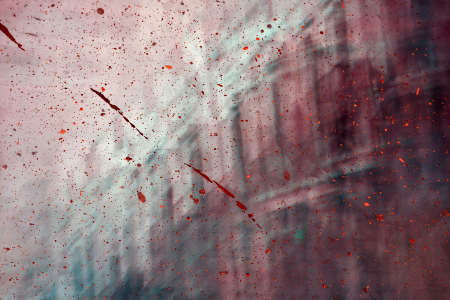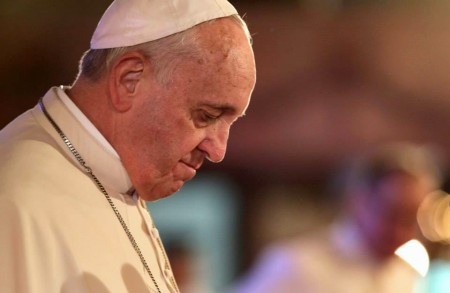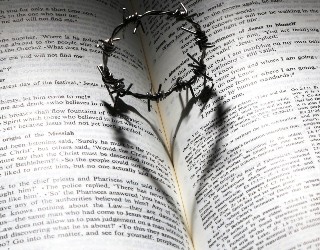We ask you, humbly: don't scroll away.
Hi readers, it seems you use Catholic Online a lot; that's great! It's a little awkward to ask, but we need your help. If you have already donated, we sincerely thank you. We're not salespeople, but we depend on donations averaging $14.76 and fewer than 1% of readers give. If you donate just $5.00, the price of your coffee, Catholic Online School could keep thriving. Thank you.Help Now >
Rome Notes: A Bewitching Tradition; Macho Monks
FREE Catholic Classes
Where La Befana Bumps Santa Aside
By Elizabeth Lev
ROME, JAN. 7, 2005 (Zenit) - Christmas brought crčches, big, fancy or small,
And mighty green fir trees amazingly tall.
New Year's changed Rome to a city of light.
Feting with fireworks all through the night.
Now we prepare for the season's last pitch,
As Romans await the old Christmas witch ...
What? A Christmas witch, you ask? While unfamiliar to most people outside of Europe, the ugly old woman bearing gifts has been a staple of Italian Christmases for centuries.
Her name, "la Befana," is a corruption of the Greek word "epiphaneia" which means manifestation and is the origin of Epiphany, or the feast of the Magi, on Jan 6.
According to legend, when the Wise Men were looking for the newborn Christ Child, they came across an old woman and told her they were going to offer gifts to the King of Kings. The old woman, too engrossed in cleaning and tending to her own home, declined the invitation to join them.
Shortly thereafter she realized her mistake, but the Magi were already gone. She gathered up food and gifts and went off in search of the child. She has been searching ever since.
We ask you, humbly: don't scroll away.
Hi readers, it seems you use Catholic Online a lot; that's great! It's a little awkward to ask, but we need your help. If you have already donated, we sincerely thank you. We're not salespeople, but we depend on donations averaging $14.76 and fewer than 1% of readers give. If you donate just $5.00, the price of your coffee, Catholic Online School could keep thriving. Thank you.Help Now >
Italian children eagerly await the night of Jan. 5, when the Befana flies over their houses on her broomstick dispensing candy and toys to good children and charcoal to the naughty ones. To ensure her arrival, they leave a little wine as well as an orange out for her.
The Befana represents an interesting interplay between pagan and Christian traditions in Italy as elements of her story have their antecedents in folklore while her very name belies her Christian roots.
The tradition of the old woman bearing gifts can be traced to the 13th century where celebrations for her arrival included dances, bonfires and songs. These festivities probably stem from the ancient tradition of gift-giving among Christians on Jan. 6 in commemoration of the Magi. The Befana was "officially" given her name during the Renaissance, through the rhymes of Tuscan poet Agnolo Firenzuola.
During the pagan era, the winter solstice was a time of many feasts linked to agriculture. The most important honored Saturn, god of agriculture. The Befana's preference for both giving and receiving foodstuffs seems to be linked to these rites concerned with the fertility of the land.
In the third century, Emperor Aurelian proclaimed a festival of the sun from Dec. 25 to Jan. 6, and on the 12th night, a trunk of an oak tree was burned all night to obtain charcoal from which the auspices for next year's crops were read.
New Year's celebrations in Italian folklore included burning a straw effigy of an old woman, symbolic of the ending of the old year and the beginning of the new. Furthermore, throughout Europe, Twelfth Night was considered the most magical night of the year, as Shakespeare knew quite well.
In postwar Italy, the Befana, already laden with traditions and meanings took on a new guise -- the rival of Santa. Italians identified Santa Claus -- with his Coca-Cola colors and his jolly, round belly -- with the affluent, commercial United States, while the Befana became leaner and her ragged clothing more obviously patched, representing poorer, war-torn Italy.
Today, the many-faceted nature of the Befana is lost on most Italians who now see her as an opportunity to receive the gifts they didn't get on Christmas Day. This week, Romans flock to Piazza Navona where the Bernini sculptures are obscured by stall after stall selling broom-wielding Befana dolls in every shape and size, copious stockings for the Befana's booty and, of course, every candy imaginable including sugar charcoal.
The only things missing are the Magi. Amid the numerous stands and wares, one is hard-pressed to find many figurines of the Wise Men to add to the crčche on Epiphany. Perhaps on her journeys, the Befana will rediscover her Christian origins and help the Magi find their way back into the hearts of Italian children.
* * *
Brothers-in-arms
"Monks at Arms," a new exhibit in Rome, captured the city's imagination this season. Many sharpened their wits dubbing the show with titles such as "macho monks" or "militant monasteries," names that emphasize what appears as a paradox in modern society, the religious brother who was also a trained warrior.
This exhibit brings together about 150 artifacts from all over the world pertaining to the religious military orders of the Knights Templar, the Knights of St. John, Jerusalem, Rhodes and Malta, and the Teutonic Knights as well as the Knights of St. Stephen. Most of these orders were formed around the 12th century, during the time of the Crusades.
Some of these communities started as hospices, providing shelter and care for pilgrims who made the arduous journey to the Holy Land. Eventually their roles evolved to include protecting the lives of these simple, unworldly voyagers. The pilgrimage to foreign lands meant not only exposure to unfamiliar climates, languages, foods and customs, but also to the danger of robbery by brigands or even abduction and sale into slavery by the Seldjuk Turks.
The military orders served the faithful, risking their lives for those who were unable to defend themselves. As the pilgrim traveled to the Holy Land to save his soul, so the knights labored to preserve his body. In a violent world of constant war and vehement hostility against Christians, there was no contradiction in the dual roles of the monk-knights.
The show introduces each order separately, starting with the Templars. The first glass case displays three pieces of parchment next to a battered iron helmet. Each document is more fascinating than the last. The first paper lists the charges brought by princes and prelates against Pope Boniface VIII in 1303, the second is a letter from the French Inquisition preparing the interrogation of the Templars, and the third scroll contains the inventory of the goods seized from the Knights Templar after their suppression by Pope Clement V in 1307 at the Council of Vienne.
These yellowing wrinkled documents offer an intriguing glimpse into a distant past, evoking the tumultuous political backdrop against which Dante wrote "The Divine Comedy" and Giotto painted the Scrovegni Chapel.
 Hi readers, it seems you use Catholic Online a lot; that's great! It's a little awkward to ask, but we need your help. If you have already donated, we sincerely thank you. We're not salespeople, but we depend on donations averaging $14.76 and fewer than 1% of readers give. If you donate just $5.00, the price of your coffee, Catholic Online School could keep thriving. Thank you. Help Now >
Hi readers, it seems you use Catholic Online a lot; that's great! It's a little awkward to ask, but we need your help. If you have already donated, we sincerely thank you. We're not salespeople, but we depend on donations averaging $14.76 and fewer than 1% of readers give. If you donate just $5.00, the price of your coffee, Catholic Online School could keep thriving. Thank you. Help Now >
Next come the Knights of St. John founded in Jerusalem in 1099, now better known as the Knights of Malta, whose exploits brought them to Rhodes and Malta before they established their present headquarters on the Aventine Hill in Rome. As the Knights of Malta are still very active today, both running hospitals and providing relief in emergency situations around the world, artifacts representing numerous phases of their activity are prominently featured in the exhibit.
While the model of a Maltese galley -- the low, fast, oar-powered boat that tormented the Turkish fleet -- commands attention, the most captivating item is the dress armor in steel and gold, worn by Jean de la Vallette, grand master of the order. This hero of the siege of Malta in 1565 personifies the ideal of a monk-knight. His ingenious defense tactics and stalwart honor enabled 600 knights to hold off the Turkish fleet and save Europe from invasion by the Ottomans.
Also worthy of note is the armor of Alof di Wignacourt, a Maltese grand master who was immortalized in a Caravaggio portrait after Wignacourt had conferred a knighthood on the painter. (Film noir fans please note: The exhibit sheds no light on the current whereabouts of "The Maltese Falcon.")
The Teutonic Order is represented by relatively few objects, but their little wooden standard with a simple back cross, calls to mind the Spartan lives of these soldiers, and the deprivations, discomforts and dangers they endured in pursuit of their vocation.
The Order of St. Stephen is a bit of an anomaly, as it was founded by the Medici dukes of Tuscany. The most aristocratic of the military communities, with counts, princes and kings among its members, it is the source of some of the most exquisite objects of the show, including elaborate daggers, filigree swords and one of the purple silk robes worn by the knights.
The exhibit draws to a close with an example of several Christian military forces working in unison, side by side. The Holy Alliance, comprising the papal, Spanish and Venetian fleets aided by the Knights of Malta, defeated the Turkish fleet on Oct. 7, 1571, at the Battle of Lepanto, now celebrated as the feast of the Holy Rosary. One of the captured Turkish standards, its crescent moons faded by time, holds court in the center of the room.
The "Monks at Arms" exhibit is aptly housed in the Castel Sant'Angelo, formerly the papal fortress. The wall connecting the fort to the present-day papal palace contains a passageway, the "passetto" which saved the life of Pope Clement VII Medici during the sack of Rome in 1527. The exhibit and its setting are reminders that even the papacy has known times of menace and violence.
Contact
Catholic Online
https://www.catholic.org
CA, US
Catholic Online - Publisher, 661 869-1000
info@yourcatholicvoice.org
Keywords
Rome, Notes, Monks, Tradition,
More Catholic PRWire
Showing 1 - 50 of 4,716
A Recession Antidote
Randy Hain
Monaco & The Vatican: Monaco's Grace Kelly Exhibit to Rome--A Review of Monegasque-Holy See Diplomatic History
Dna. Maria St. Catherine Sharpe, t.o.s.m., T.O.SS.T.
The Why of Jesus' Death: A Pauline Perspective
Jerom Paul
A Royal Betrayal: Catholic Monaco Liberalizes Abortion
Dna. Maria St.Catherine De Grace Sharpe, t.o.s.m., T.O.SS.T.
Embrace every moment as sacred time
Mary Regina Morrell
My Dad
JoMarie Grinkiewicz
Letting go is simple wisdom with divine potential
Mary Regina Morrell
Father Lombardi's Address on Catholic Media
Catholic Online
Pope's Words to Pontifical Latin American College
Catholic Online
Prelate: Genetics Needs a Conscience
Catholic Online
State Aid for Catholic Schools: Help or Hindrance?
Catholic Online
Scorsese Planning Movie on Japanese Martyrs
Catholic Online
2 Nuns Kidnapped in Kenya Set Free
Catholic Online
Holy See-Israel Negotiation Moves Forward
Catholic Online
Franchising to Evangelize
Catholic Online
Catholics Decry Anti-Christianity in Israel
Catholic Online
Pope and Gordon Brown Meet About Development Aid
Catholic Online
Pontiff Backs Latin America's Continental Mission
Catholic Online
Cardinal Warns Against Anti-Catholic Education
Catholic Online
Full Circle
Robert Gieb
Three words to a deeper faith
Paul Sposite
Relections for Lent 2009
chris anthony
Wisdom lies beyond the surface of life
Mary Regina Morrell
World Food Program Director on Lent
Catholic Online
Moral Clarity
DAN SHEA
Pope's Lenten Message for 2009
Catholic Online
A Prayer for Monaco: Remembering the Faith Legacy of Prince Rainier III & Princess Grace and Contemplating the Moral Challenges of Prince Albert II
Dna. Maria St. Catherine Sharpe
Keeping a Lid on Permissiveness
Sally Connolly
Glimpse of Me
Sarah Reinhard
The 3 stages of life
Michele Szekely
Sex and the Married Woman
Cheryl Dickow
A Catholic Woman Returns to the Church
Cheryl Dickow
Modernity & Morality
Dan Shea
Just a Minute
Sarah Reinhard
Catholic identity ... triumphant reemergence!
Hugh McNichol
Edging God Out
Paul Sposite
Burying a St. Joseph Statue
Cheryl Dickow
George Bush Speaks on Papal Visit
Catholic Online
Sometimes moving forward means moving the canoe
Mary Regina Morrell
Action Changes Things: Teaching our Kids about Community Service
Lisa Hendey
Easter... A Way of Life
Paul Spoisite
Papal initiative...peace and harmony!
Hugh McNichol
Proclaim the mysteries of the Resurrection!
Hugh McNichol
Jerusalem Patriarch's Easter Message
Catholic Online
Good Friday Sermon of Father Cantalamessa
Catholic Online
Papal Address at the End of the Way of the Cross
Catholic Online
Cardinal Zen's Meditations for Via Crucis
Catholic Online
Interview With Vatican Aide on Jewish-Catholic Relations
Catholic Online
Pope Benedict XVI On the Easter Triduum
Catholic Online
Holy Saturday...anticipation!
Hugh McNichol
We ask you, humbly: don't scroll away.
Hi readers, it seems you use Catholic Online a lot; that's great! It's a little awkward to ask, but we need your help. If you have already donated, we sincerely thank you. We're not salespeople, but we depend on donations averaging $14.76 and fewer than 1% of readers give. If you donate just $5.00, the price of your coffee, Catholic Online School could keep thriving. Thank you.Help Now >











 Daily Readings for Friday, April 19, 2024
Daily Readings for Friday, April 19, 2024 St. Alphege: Saint of the Day for Friday, April 19, 2024
St. Alphege: Saint of the Day for Friday, April 19, 2024 Stewardship Prayer: Prayer of the Day for Friday, April 19, 2024
Stewardship Prayer: Prayer of the Day for Friday, April 19, 2024

